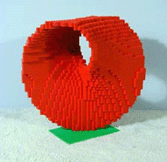
« PREVIOUS ENTRY
Be your own ISP — with Speakeasy Wifi!

As most geeks know, playing with Lego is superb training in math and geometry. Indeed, many schools now explicity offer “Lego and math” classes. When you have to calculate the number and type of bricks necessary to make a weird shape, or when you try to create a curve out of square bricks, you quickly run into concepts like fractions, exponents, and squares, cubes and roots. When I first learned about the idea of logarithmic scale, it made immediate sense — because I’d once had the same idea while plotting out brick space on a big flat Lego pad.
Now, Andrew Lipson … this guy’s nuts. Though I mean that in a good way. He essentially performs Xtreme math using Lego bricks: He’s devoted the last few years to developing Lego models of famous geometric shapes, including the Moebius strip (pictured above), the Moebius-like “Klein Bottle”, and the incredibly weird, single-surfaced Bour’s surface. Want to build them yourself? Here’s how Lipson did it:
OK, I admit it — these weren’t constructed entirely without computer assistance. Usually I write some C code to generate whatever the shape is and figure out which cells in a grid made up of 1x1x1 LEGO bricks should be filled in. The code outputs this as an LDraw .DAT file, separated into construction steps adding one complete layer of the structure in each step. Then I use MLCad to view the .DAT file. I play around with the parameters and repeat until I have something that looks nice and which will probably be able to balance.
I'm Clive Thompson, the author of Smarter Than You Think: How Technology is Changing Our Minds for the Better (Penguin Press). You can order the book now at Amazon, Barnes and Noble, Powells, Indiebound, or through your local bookstore! I'm also a contributing writer for the New York Times Magazine and a columnist for Wired magazine. Email is here or ping me via the antiquated form of AOL IM (pomeranian99).

ECHO
Erik Weissengruber
Vespaboy
Terri Senft
Tom Igoe
El Rey Del Art
Morgan Noel
Maura Johnston
Cori Eckert
Heather Gold
Andrew Hearst
Chris Allbritton
Bret Dawson
Michele Tepper
Sharyn November
Gail Jaitin
Barnaby Marshall
Frankly, I'd Rather Not
The Shifted Librarian
Ryan Bigge
Nick Denton
Howard Sherman's Nuggets
Serial Deviant
Ellen McDermott
Jeff Liu
Marc Kelsey
Chris Shieh
Iron Monkey
Diversions
Rob Toole
Donut Rock City
Ross Judson
Idle Words
J-Walk Blog
The Antic Muse
Tribblescape
Little Things
Jeff Heer
Abstract Dynamics
Snark Market
Plastic Bag
Sensory Impact
Incoming Signals
MemeFirst
MemoryCard
Majikthise
Ludonauts
Boing Boing
Slashdot
Atrios
Smart Mobs
Plastic
Ludology.org
The Feature
Gizmodo
game girl
Mindjack
Techdirt Wireless News
Corante Gaming blog
Corante Social Software blog
ECHO
SciTech Daily
Arts and Letters Daily
Textually.org
BlogPulse
Robots.net
Alan Reiter's Wireless Data Weblog
Brad DeLong
Viral Marketing Blog
Gameblogs
Slashdot Games